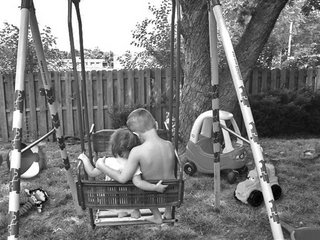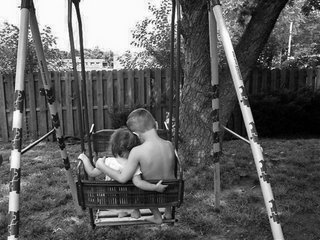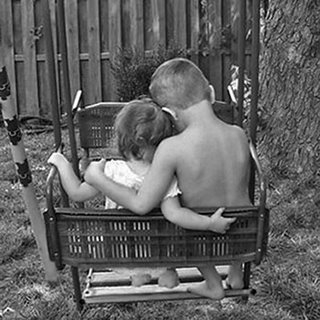
The first picture shows a boy and girl sitting together in a swing. What’s the story here? The kids? The yard? The array of toys?

The second picture shows the same children on the swing set, but the clutter is gone. The children stand out clearly, while the yard and surroundings are still part of the picture.

The third picture is cropped to focus specifically on the children. The surroundings are almost irrelevant. They show only enough to give the picture context.
Which is the better picture? Aside from esthetics, it’s a matter of personal preference — and purpose. With a little help from a photo editing program, the same photo yielded all three results. The first pictures shows the kids in the yard where they spend time with all their toys. It’s a vignette of daily life. The second picture is “cleaned up.” It doesn’t show the details of daily life, but the yard and swing set are still part of the picture’s story. The third picture seems to focus entirely on the affectionate relationship between the two children, presumably brother and sister.
You can do similar things with your stories. I confess that none of the pictures exactly reflect the original. I added extra toys to the first (borrowed from the actual collection), and removed even the originals in the second. The third is simply enlarged and cropped from the original. In the same way, a little editing and pruning, or perhaps adding a few details, will give a variety of results from the same basic story material. If your purpose is to document daily life, you’ll include different sorts of details, and probably more of them, than you would if your purpose were sharing a humorous anecdote or reflecting on the meaning of your life. As you sort through the thoughts you wrote in your first draft, compare each thought to your purpose as you consider whether to keep it, scratch it out, or maybe add a few more details.
Take a look at some of your own stories. So you see ways to crop them or change the variety of detail to improve them?
Write on,
Sharon Lippincott, aka Ritergal

4 comments :
I prefer the closeup for the same reasons that I like closeups in movies.
It gets us closer to the charaters emotions, feelings etc.
When pulled away from the subject it seems that I am waiting for someone to walk into the frame, on close ups you know it is only about the subjects of the pictures.
Thanks Blue,
I tend to agree with you, and if I'd taken the picture myself, I would have zoomed in on the kids.
Rather than logging a long reply to your comment, I'm going to use it as a follow-up message here.
As a visual learner, this is a great illustration of how to edit a piece. One difference in writing and photo taking is that at times the moment presents itself and we are in a hurry to make sure we capture it when it is available.
Often I write as the thoughts come to me and edit later. I'm in a rush of what is often referred to as flow, and if I stop to edit, the action slows to a crawl and some of what is in the air may disappear. Sketching an idea or capturing a picture are certainly about timing. With luck, we have time to edit after the initial fact.
Photography is such an open art. Nearly everyone owns a camera. So few are skillful at capturing in the lens what they see with their eyes. At times in a hurry to capture a scene the image is not the most perfect possible.
Writing is something nearly anyone can do. Fortunately it usually allows a time frame in order to edit the thoughts that have just spilled thru the ethers. Often I write quite freestyle to capture the entire concept, knowing that I have time later to make edits. If I edit as I write, it is easy to lose the momentum and get to the finale of the piece.
As I am visual, I agree that there are certainly better frames of a shot perhaps taken in a moment of hurry up before the subject moves. Fortunately there are those who are skilled in PhotoShop and other programs who can improve on those pics that can be edited to a better form. As a visually motivated person, this is an excellent illustration of how editing and being able to manipulate an image relates to our abilities to edit and manipulate our writing.
My writing often serves to show the example of 'wordiness' so after I post this message, I will undoubtedly figure out some better ways to express what I am trying to say. So "shoot" me. LOL
Post a Comment